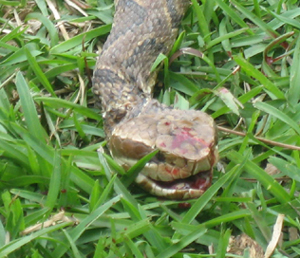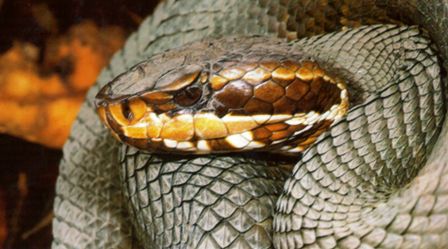Large-headed water snake
Big-headed grass snake (Natrix megalocephala )
The big-headed - grass snake (Natrix megalocephala ) counts within the family of snakes ( Colubridae ) to the genus of the European water snakes ( Natrix ). The taxonomic status of this species described by Russian authors in 1987 is disputed. It is possible that only a subspecies of the grass snake (Natrix natrix ), presumably to particularly strong examples of the Siberian grass snake (Natrix n scutata ). Its distribution is limited to the Caucasian region.
Features
This snake reaches a body length of 80 to 120 centimeters. It is built relatively strong - striking is the relatively large head of the animal. The latter has the larger plates with fine relief pattern on the upper side, a Voraugenschild ( Praeoculare ) three background eye shields ( Postocularia ) and seven to eight upper lip plates ( supralabials ) on. The last three upper lip shields are very large and the third and fourth encounter at the edge of the eye. The eyes have a round pupil. The entire back, the flanks and the top of the head are uniformly black. Under the heads, lower lip Signs ( Sublabialia ) and partly the upper lip plates are brightly colored. The ventral scales ( Ventralschilder ) are mottled gray black and bright, the tail tip but pure black. The body sheds the bulk head grass snake are smooth, it has 18-19 dorsal scale rows.
Way of life
The ground-dwelling Grosskopf - grass snake performs a diurnal lifestyle and shy, but keeps himself in great heat during the day mostly in the shade. When threatened, the snake flees into running and hiding under water. In the lowlands it has a hibernation period of nearly four months, in mountainous areas seven months from late September to late April. To their prey spectrum include salamanders and anurans, and occasionally fish. The big-headed - Grass Snake is oviparous, that is oviparous. The nest may include relatively large eggs to 15.
Occurrence
The big-headed - grass snake is widespread within the Caucasus -Black Sea region in Azerbaijan, Georgia, Russia and Turkey. The habitats are lowland forests, waters close, sparse forests with evergreen undergrowth, forest edges and glades. As Kulturfolgerin they are found also on the edges or on tea plantations. In the Caucasus Mountains, Flathead grass snake penetrates until at altitudes of 1500 meters.
Endangering
Natrix megalocephala is generally not very numerous, and the stock is decreasing. The main problem is introduced Raccoons are strong competitors for food, as well as the loss of habitat as a result of tourism along the Black Sea coast. The World Conservation Union ( IUCN ) lists the species as "vulnerable ", ie risk.










